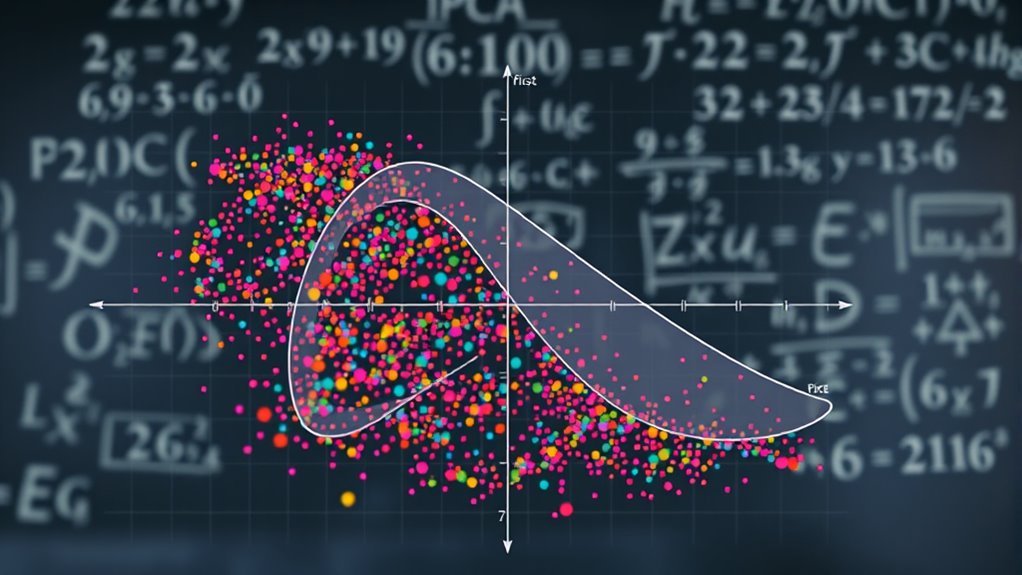You’ll use Principal Component Analysis (PCA) to reduce dimensionality by transforming correlated variables into a smaller set of uncorrelated components while preserving maximum variance. Start by standardizing your data, then compute the covariance matrix, extract eigenvalues and eigenvectors, and select top components based on explained variance. This technique streamlines analysis and removes noise but assumes linear relationships and is sensitive to outliers. Understanding these facets prepares you to explore its practical applications and challenges further.
Understanding the Basics of PCA

Although PCA might seem complex at first, it’s a powerful technique you’ll use to reduce dimensionality while preserving as much variance as possible. By transforming correlated variables into a smaller set of uncorrelated components, PCA applications enable you to simplify data analysis and visualization without significant information loss. This freedom to distill essential features aids in pattern recognition, noise reduction, and efficient data compression. However, you must acknowledge PCA limitations: it assumes linear relationships and may overlook nonlinear structures critical in some datasets. Additionally, interpreting principal components can be challenging since they represent combinations of original variables rather than direct features. Understanding these basics equips you to apply PCA effectively, balancing dimensionality reduction benefits against its constraints for ideal data-driven decision-making.
The Mathematics Behind Principal Component Analysis

To grasp how PCA reduces dimensions, you’ll need to start with computing the covariance matrix of your data to understand feature relationships. Next, extracting eigenvalues and eigenvectors helps identify the principal components that capture the most variance. Finally, projecting your data onto these components transforms it into a lower-dimensional space while preserving essential information.
Covariance Matrix Computation
Before you can identify the principal components, you need to quantify how your data variables vary together, which is done by computing the covariance matrix. This matrix captures the pairwise covariances between all variables, revealing the strength and direction of their linear relationships. By centering your data—subtracting the mean from each variable—you guarantee the covariance matrix accurately reflects variability around the mean, not skewed by offsets. The covariance matrix is symmetric, with diagonal elements representing each variable’s variance and off-diagonal elements indicating covariances between variable pairs. Understanding these data relationships is vital because the covariance matrix forms the foundation for PCA, enabling you to identify axes that maximize variance and consequently reduce dimensionality without losing essential information.
Eigenvalues and Eigenvectors
Once you’ve computed the covariance matrix, you’ll need to determine its eigenvalues and eigenvectors to uncover the principal components. Eigenvalues indicate the amount of variance each principal component captures—this eigenvalue significance guides you in selecting components that represent the data efficiently. Eigenvectors, on the other hand, define the direction of these components in the feature space. Their interpretation reveals how original variables combine to form each principal component, offering insight into underlying data structure. By analyzing both eigenvalues and eigenvectors, you gain a mathematical foundation to reduce dimensionality without losing essential information. This step is vital, as it empowers you to identify the axes that maximize variance, granting freedom to work with simplified data while preserving its intrinsic patterns.
Data Projection Techniques
Although eigenvalues and eigenvectors reveal the principal components, you still need to project your original data onto these new axes to achieve dimensionality reduction. This data transformation compresses information by aligning data along directions of maximum variance, enhancing feature selection effectiveness. You multiply your centered data matrix by the eigenvector matrix, resulting in a lower-dimensional representation.
| Step | Description |
|---|---|
| Centering | Subtract mean from each feature |
| Eigen Decomposition | Compute eigenvalues and eigenvectors |
| Projection | Multiply data by eigenvectors |
| Feature Selection | Choose components with highest variance |
This technique preserves essential patterns, granting you freedom to analyze compact, informative data without losing critical information.
When and Why to Use PCA in Data Analysis

Since high-dimensional datasets often contain correlated or redundant features, you’ll find that PCA is valuable for reducing dimensionality while preserving the most informative variance. PCA benefits include simplifying data, improving visualization, and enhancing algorithm performance by mitigating the curse of dimensionality. However, PCA limitations exist, such as losing interpretability and sensitivity to scaling. You should use PCA when:
PCA reduces dimensionality by preserving key variance, improving visualization and algorithm efficiency despite some interpretability loss.
- You want to compress data without losing critical information
- Your dataset has multicollinearity among variables
- You need to remove noise and redundant features
- Visualization of complex datasets is required
Steps to Perform PCA on a Dataset
Performing PCA on a dataset involves five key steps that transform your original variables into principal components. First, you begin with data preprocessing—standardize your dataset to guarantee variables with different scales contribute equally. Next, compute the covariance matrix to capture relationships among variables, crucial for PCA applications. Third, extract eigenvalues and eigenvectors from this matrix; eigenvectors define principal component directions, eigenvalues quantify variance explained. Fourth, select principal components based on eigenvalues, balancing dimensionality reduction and information retention. Finally, project your standardized data onto these components, yielding a transformed dataset with reduced dimensions. This process lets you streamline complex data while preserving essential variance, releasing freedom to analyze and visualize with greater clarity and efficiency.
Interpreting Principal Components and Explained Variance
When you analyze principal components, you’re fundamentally uncovering new axes that capture the maximum variance in your data. Each principal component represents a direction where data variability is maximized, and understanding this helps you prioritize which components to keep. Explained variance quantifies the amount of total variance each principal component accounts for, guiding dimensionality reduction decisions.
Consider these insights as you interpret:
Consider these insights carefully to effectively interpret and leverage principal components in your data analysis.
- The first principal component explains the largest variance slice, often revealing dominant patterns.
- Subsequent components capture orthogonal variance, highlighting independent structures.
- Cumulative explained variance indicates how much original data variability you retain.
- Small explained variance in later components suggests they contribute minimal information.
Visualizing Data After Dimensionality Reduction
How can you effectively interpret your data after reducing its dimensionality? Visualization is key. Scatter plots provide a straightforward method to observe the distribution and clustering of data points in the reduced space. By plotting the first two or three principal components, you can identify patterns, groupings, or outliers that weren’t obvious before. Additionally, biplot analysis enhances this by overlaying variable vectors onto scatter plots. This dual representation lets you see both the observations and how original variables contribute to each principal component, offering deeper insights. Using these visualization techniques, you gain freedom to explore complex datasets intuitively, making informed decisions about data structure and relationships without being overwhelmed by high dimensionality. Well-crafted prompts guide the analytical journey and can enhance the effectiveness of your exploratory visualization process.
Common Challenges and Pitfalls in PCA
Although PCA is a powerful tool for reducing dimensionality, you must be aware of several challenges that can compromise its effectiveness. Overfitting issues may arise if too many components are retained, while improper scaling can distort variance and mislead results. Noise sensitivity often masks true structure, and outlier influence can skew principal components, complicating interpretation. Feature selection prior to PCA remains critical to reduce computation complexity and enhance clarity. Visualization challenges persist because reduced dimensions may not capture all meaningful variance.
- Ignoring scaling importance leads to biased components.
- Outliers disproportionately affect component directions.
- Noise sensitivity reduces signal clarity.
- Overfitting issues emerge with excessive components.
Understanding these pitfalls lets you use PCA effectively, preserving freedom in your data analysis.
PCA Vs Other Dimensionality Reduction Techniques
Understanding the limitations of PCA, such as sensitivity to outliers and noise, helps frame its comparison with other dimensionality reduction methods. While PCA advantages include simplicity, computational efficiency, and effectiveness in linear data, its PCA limitations restrict its use in capturing nonlinear structures. Techniques like t-SNE and UMAP address these limitations by preserving local data relationships and manifold structures, offering superior visualization capabilities. However, PCA remains preferable in PCA applications requiring interpretability and global variance explanation. When making PCA comparisons, consider your data’s characteristics and the trade-off between dimensionality reduction accuracy and computational cost. Ultimately, your choice hinges on balancing PCA’s linear assumptions against alternative methods’ nonlinear strengths, enabling you to select the best tool for your dimensionality reduction needs.
Real-World Applications of PCA
Where can you see Principal Component Analysis making a tangible impact outside theory? PCA streamlines complex datasets, empowering you to extract meaningful insights across diverse fields. In image recognition and speech recognition, it reduces dimensionality to enhance pattern detection and real-time processing. Financial analysis and fraud detection benefit from PCA by uncovering hidden correlations and anomalies. When working with genomic data, PCA identifies principal genetic variations, aiding healthcare diagnostics. In marketing strategies, customer segmentation and social media analytics leverage PCA to distill consumer behavior and trends efficiently.
PCA transforms complex data into clear insights, powering advancements in recognition, finance, healthcare, and marketing.
- Accelerating climate modeling through dimensionality reduction in vast environmental data
- Enhancing fraud detection by isolating key risk factors in financial transactions
- Improving healthcare diagnostics with genetic and clinical data integration
- Optimizing marketing strategies via refined customer segmentation and social media insights
PCA enables freedom by simplifying complexity, delivering clarity in data-driven decisions.
Implementing PCA Using Popular Programming Libraries
You can efficiently implement PCA using Scikit-Learn’s built-in functions, which handle data scaling, decomposition, and variance explanation seamlessly. Once you extract principal components, visualizing them through scatter plots or biplots helps interpret the reduced dimensional space. These tools streamline the evaluation of PCA’s effectiveness on your dataset and guide further analysis.
PCA With Scikit-Learn
Although PCA can be implemented from scratch, leveraging Scikit-Learn simplifies the process considerably by providing optimized, reliable functions for dimensionality reduction. You can quickly apply PCA to datasets, handling PCA applications like noise reduction and feature extraction while being mindful of PCA limitations such as linearity assumptions. Using Scikit-Learn, you’ll:
- Standardize data with `StandardScaler` for consistent variance
- Instantiate `PCA` with desired components
- Fit and transform data in one step
- Access explained variance ratios to evaluate component significance
This approach frees you from manual matrix operations, enabling faster experimentation and model integration. Scikit-Learn’s PCA lets you focus on interpreting results and adapting to your problem’s constraints, ensuring you harness PCA’s strengths without reinventing the wheel.
Visualizing PCA Results
Effective visualization is essential for interpreting PCA results and communicating the underlying data structure. When you implement PCA using libraries like Scikit-Learn or Matplotlib, scatter plots allow you to project high-dimensional data onto principal components, revealing clusters and trends. Biplot visualizations extend this by combining the scatter plot of samples with vectors representing feature contributions, offering deeper insights. These plots empower you to grasp variance distribution and feature influence simultaneously.
| Visualization Type | Purpose | Library/Function |
|---|---|---|
| Scatter Plot | Display data in PC space | Matplotlib, Seaborn |
| Biplot | Show samples + feature vectors | Custom Matplotlib code |
| Scree Plot | Visualize explained variance | Matplotlib, Seaborn |
| Cumulative Variance | Track total variance explained | Matplotlib |
Using these techniques, you gain freedom to analyze and present PCA outcomes precisely.



